 Relax, honey. They must be from that boat with the skull flag. I bet they're spring breakers on a booze cruise. 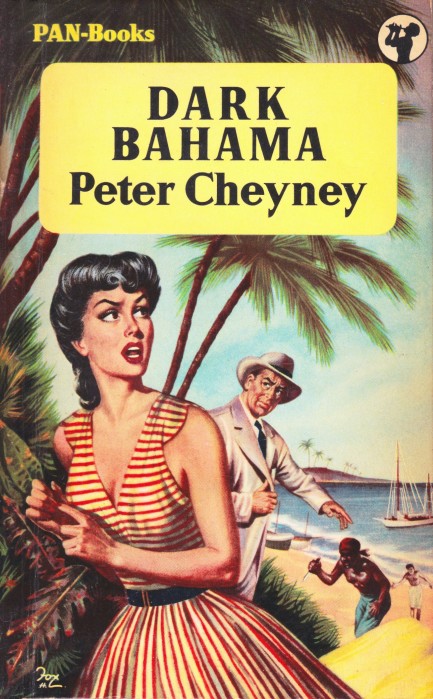
The 1960 Fontana edition of Peter Cheyney's Dark Bahama, with its unlucky man being mauled by a shark, is one of the craziest mid-century paperback covers you'll see. By contrast, the earlier 1957 edition above from Pan Books goes a bit more traditional. It was painted by Henry Fox, easily recognizable thanks to his unique signature at lower left. The book is unique too. Feel free to read the earlier write-up to find out how.
 Poitier heads to parts unknown after a long and unique career. 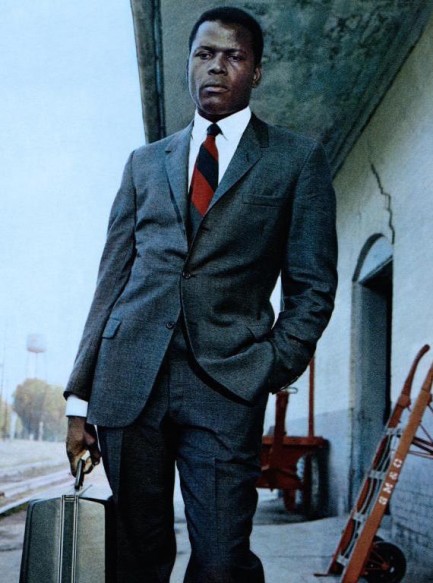
Above is a photo of one-of-a-kind actor and cultural icon Sidney Poitier, who died yesterday aged ninety-four in the Bahamas, where he was born and lived much of his life. He starred in a couple of our favorite lightweight movies, including 1961's Paris Blues and 1992's Sneakers, but this shot is from 1967's unforgettable and topical drama In the Heat of the Night, one of many landmark movies in which he starred. He changed the game. That's really all you can say. See another cool shot of him here.
 Turns out sharks like the catch of the day too. 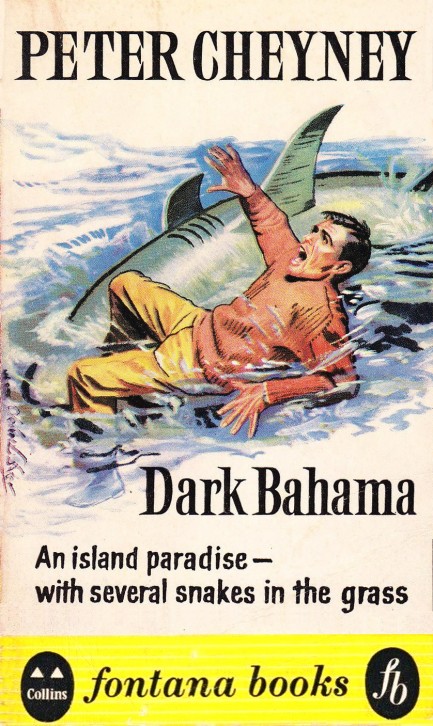
As soon as we saw this cover for Peter Cheyney's 1950 novel Dark Bahama we had to read the book. We had to find out if this was a literal illustration. And yep, a guy gets eaten by a shark. The artist here, John L. Baker, painting this for Fontana's 1960 edition, must have really enjoyed creating something different from the usual gun toting studs and chain smoking femmes fatales. The story is different too. In a tale set on the fictional Bahamian island of Dark Bahama, Cheyney creates an array of Afro-Bahamian characters, filling roles from fishermen to police officials, and, surprisingly, writes them with something nearing respect. The addition of a mysterious Belgian character makes for another fun spot of diversity.
The protagonist is Julian Isles, a British detective hired to locate a globetrotting ingenue and rescue her from Dark Bahama before her partying and dubious associations permanently embarrass her family. Isles immediately walks into a murder scene, is suspected by the local cops, begins to think his client has lied to him, and sets about defying orders and expectations to get to the bottom of it all. Getting to the bottom involves working with the aforementioned Belgian cipher, Ernest Guelvada, a tough, romantic, eloquent, and ruthless operative of vague provenance. We think he's one of the best characters we've come across in mid-century literature. Just listen to this guy:
“I am delighted to meet you. I am more than delighted to bring a little excitement into your—what is the word—prosaic existence. Yes, goddam it, you will agree with me that there is nothing like a couple of murders to stir the blood of a police commissioner at three-thirty in the morning.”
And:
“You think so? You lie. More than that, my friend, you love her. That I know. When you speak of her I see the look in your eye. I have discovered your secret. I will tell you something else. I also love her. I, Guelvada, who loves every woman in the world, love her at least as much as the other few million.”
And:
“When I go into action, my friend, I like a lot of room and a lot of space. Like great armies I must have room to develop. Like great fleets I must have space to maneuver. You understand? It is for this reason that I do not wish this island to be cluttered up with non-essential women, and at the moment our beautiful Miss Lyon is non-essential. Therefore, she will stay in Miami.”
To us, that sounds like a writer having a very good time with an off-the-wall character. Guelvada's reasons for turning up change Dark Bahama from a mystery to an espionage tale, but we won't reveal the details. We suggest reading it yourself. Cheyney is famous for his Lemmy Caution series, which began back in 1935, but we think he's better here fifteen years later—a better stylist and a better conceptualizer, who's produced a generally better read than we think he was capable of back when he started out. The story is engaging, the femme fatale is fascinating, the secondary characters ring true, the bizarre Ernest Guelvada keeps reader interest high, and the island backdrop adds atmosphere and spice. With Dark Bahama Cheyney gave us more than our money's worth.
 When ragtag crooks hook up with a bevy of Bahama mamas a tropical storm breaks. 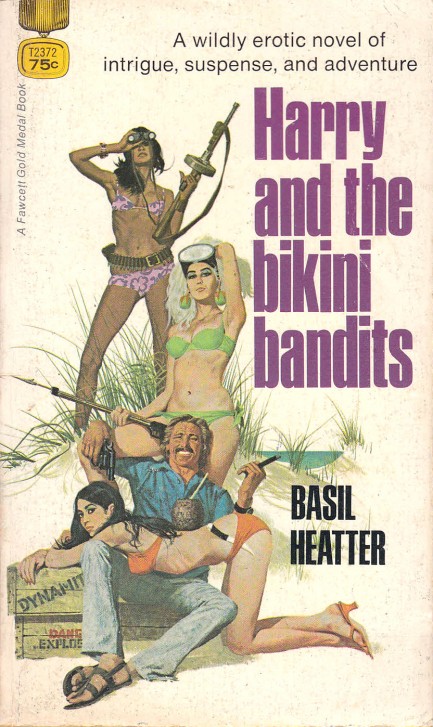
Basil Heatter 1963's novel Virgin Cay was an enjoyable tale, so when we saw this Robert McGinnis cover for Harry and the Bikini Bandits we couldn't resist. The novel, which came in 1969 with Fawcett/Gold Medal's edition appearing in 1971, is the story of seventeen-year-old Clayton Bullmore's trip to the Bahamas to see his nutty uncle Harry, who lives on a raggedy ketch and has a magic touch with women of all types. This is where the bikinis come in, but the bikini-wearers are not the bandits (except, technically, one). The bandits are Harry, a couple of his acquaintances, and Clay, who's dragged into a scheme to rob the big casino in Nassau. The combination of coming-of-age story and casino caper is fun, and Heatter mixes in humor, sex, and action, and folds it all into a winning waterborne milieu. He even manages to add a shipwreck, a deserted island, and buried treasure, so we'd say he includes all the most beloved tropes of tropical adventures. It'll make you want to run away to the Caribbean. Heatter is two-for-two in our ledger.
 They should have taken a bigger boat. 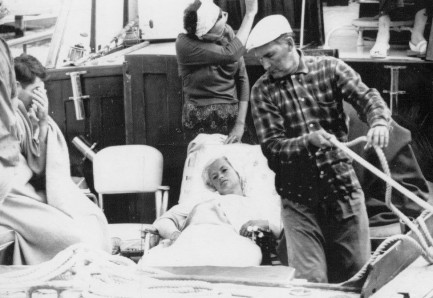 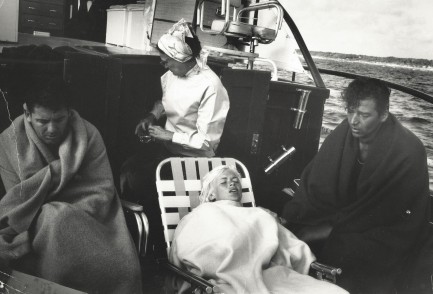
Today in 1962 Jayne Mansfield, while vacationing in the balmy Bahama Islands, failed to turn up for several evening appointments after having gone water skiing with her husband Mickey Hargitay and press agent Jack Drury. All three were feared lost at sea when the seventeen-foot motorboat they had rented was found adrift and capsized. At sundown the craft was towed to Nassau and the world waited for news. None came that night. The next morning's search for Mansfield and her companions involved four-hundred people, including the Nassau Air-Sea Rescue Squadron. Later that day a searcher flying overhead spotted a water ski floating near Rose Island, a stretch of sand about fifteen miles from Nassau. It was on the eastern end of the island that Mansfield, Hargitay, and Drury were finally found.
By this time the press had descended upon Nassau, and the spectacle of Mansfield being conducted to shore, weak and in tears, was witnessed by scores of journalists and photographers. The trio told the world a harrowing tale. Mansfield fell from her water skis, and Hargitay swam to retrieve her while Drury circled in the boat. At that point Drury saw sharks, and as they rushed to lift Mansfield into the boat it overturned. Hargitay and Drury continued trying to push Mansfield onto the now upside down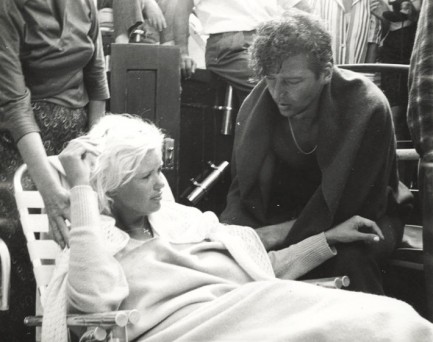 vessel, but at that point things went from bad to worse when she passed out. They got her atop the boat but could do nothing but drift. They bobbed on the waters for hours until they neared a small coral reef, decided to brave the sharks, and swam for it. There they spent the night, lacking supplies of any sort, with the tide rising until they were almost back in the sea again. At daybreak they saw that Rose Island was nearby. With the tide out, they were able to walk, wade, and swim to it. vessel, but at that point things went from bad to worse when she passed out. They got her atop the boat but could do nothing but drift. They bobbed on the waters for hours until they neared a small coral reef, decided to brave the sharks, and swam for it. There they spent the night, lacking supplies of any sort, with the tide rising until they were almost back in the sea again. At daybreak they saw that Rose Island was nearby. With the tide out, they were able to walk, wade, and swim to it.
Mansfield's stranding and rescue was a huge story, but there were many who said it was a publicity stunt. It's an interesting take on the event, considering the attending physician at Rassin Hospital, whose name was Dr. Meyer Rassin—he founded the facility—said Mansfield suffered from “quite severe exposure, and the effects of bites from numerous mosquitoes and sand flies.” Having dealt with Caribbean sand flies ourselves, we can tell you nobody would willingly put themselves through the hell of being feasted on by them. But on the other hand, sand fly bites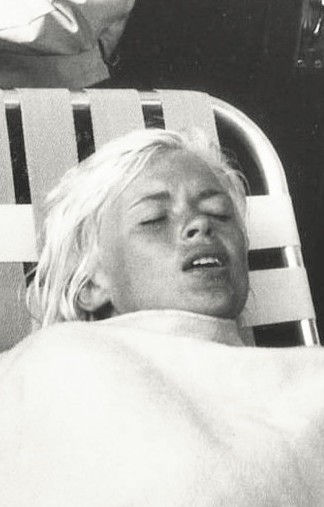 itch and swell, and when scratched they break open and bleed, yet Mansfield doesn't look particularly marked. On the other-other hand, doesn't dragging a local pilot and the respected founder of the island hospital into a fake near-death experience defy credulity?
But maybe two things were true at the same time. Maybe it started as a stunt. Maybe Mansfield and company motored to Rose Island, purposely turned the boat over and set it adrift, then waited for the pilot they'd selected to fly over the next morning. Maybe they even had food and water, and hunkered down for a night under the Caribbean stars while chortling over the free press coverage they were going to generate. But maybe they had failed to consider the sand fly aspect, and Mansfield really was in a sorry state when found, which means Dr. Rassin was being truthful. It's possible.
To us the biggest hole in Mansfield's story is the accidental capsizing of a boat seventeen feet long that's weighed down by an outboard motor. It takes serious work to overturn a floating canoe, let alone a waterskiing boat. But Mansfield was a hefty woman, Hargitay was a bodybuilder, and with Drury leaning waaaay out over the boat's gunwale, maybe they really did accidentally flip it. We'll never know what happened, which means Mansfield's big Bahamian adventure will always be a subject of speculation. But you now what? The truth is often banal. A mystery is so much more fun.
 Sharks aren't the worst predators in the water. 
Behold! The longest piece of promo art we've ever shared. The oceangoing thriller The Deep premiered in the U.S. in June 1977 as part of a wave of similar movies that came in the wake of Jaws (see what we did there, with the "wave" "wake" thing?). Yeah. So anyway, author Peter Benchley, who wrote the novels that spawned both films, used similar themes for the two, but switched the monster shark for human dangers in The Deep. The Japanese run of the film began today in 1977, and for once the Japanese title isn't something wildly different—they went with ザ・ディープ, which means “the deep.”
We've never seen anything like this poster before, and we doubt we will again. Also of note is that the movie, which was not considered top notch, was a massive hit thanks to a brilliant marketing campaign that saw co-star Jacqueline Bisset wardrobed in a white t-shirt that turned transparent when wet, such as during her opening diving scene in the warm Bahamian waters. Never had a pair of nipples made such a splash. A longtime a sex symbol and thirty-three years old when the The Deep appeared, the film made Bisset a legit superstar for the first time. 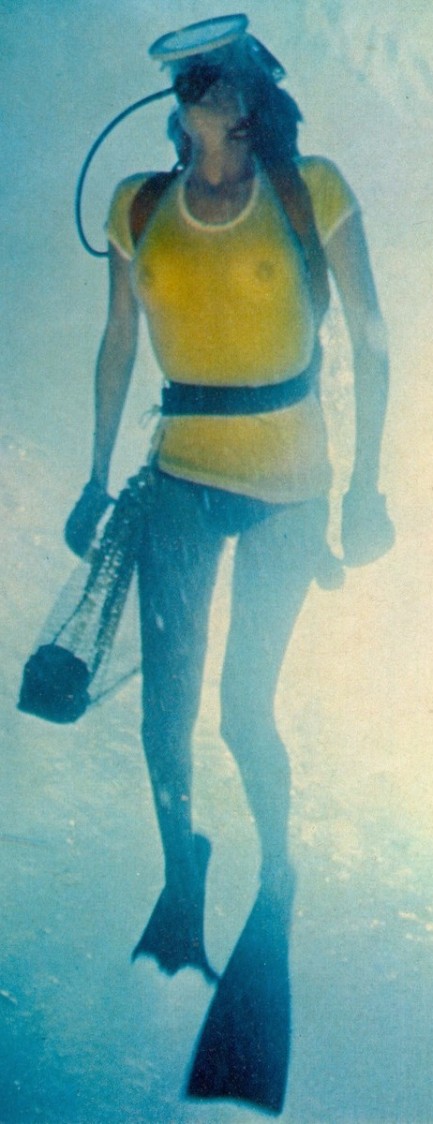
 Sidney Poitier chases the Blues away. 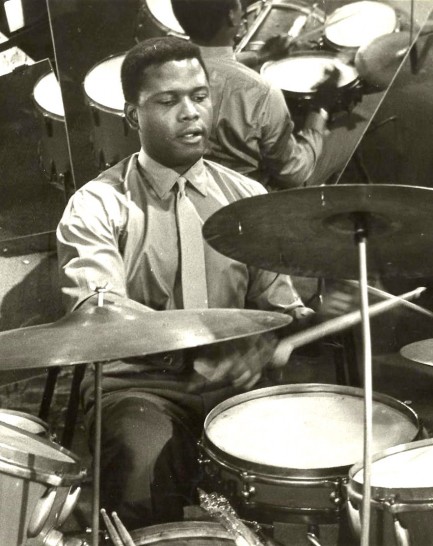
There are plenty of movies about Americans in Paris, and even a few about American jazz musicians in Paris, but for our money Paris Blues is one of the best. It starred Bahamian born actor Sidney Poitier, along with Paul Newman, Joanne Woodward, and Diahann Carroll, and above you see Poitier having a turn on the drums in the nightclub set where much of the movie's action takes place. In the film he doesn't play drums. He's actually a saxophonist. But you know how it is with drums—if they're sitting there vacant somebody's going to start pounding on them. We say that speaking as drummers—yes, both of your Pulp Intl. scribes are drummers, and if we had a dime for every time we found some hoser whaling away uninvited on our expensive gear, well... we'd have a lot of dimes. Anyway, we recommend you check out Paris Blues.
 Coconut rum, ma'am? But I only brought two straws, so I'm afraid your husband will have to bugger off. 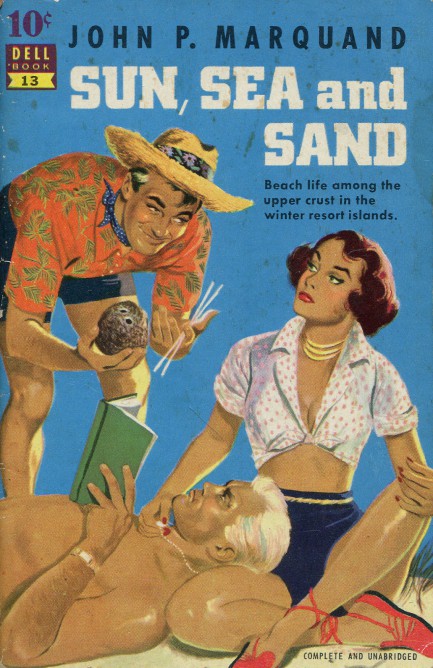
John P. Marquand won a 1938 Pulitzer Prize for The Late George Apley, so the above effort may seem a bit lightweight for him, but Marquand started out in genre fiction before becoming a leading literary figure. In his prime he specialized in satire of the upper classes, and Sun, Sea and Sand follows in that tradition, telling the tale of Epsom Felch, a problematic member of the snobbish Mulligatawny Club, which is located in the Bahamas. Epsom is a bit of a prankster, and the stuffy club membership are increasingly fed up with him, even though—as his main defender Spike constantly points out—pretty much every fun or memorable event that ever took place at the club was Epsom's 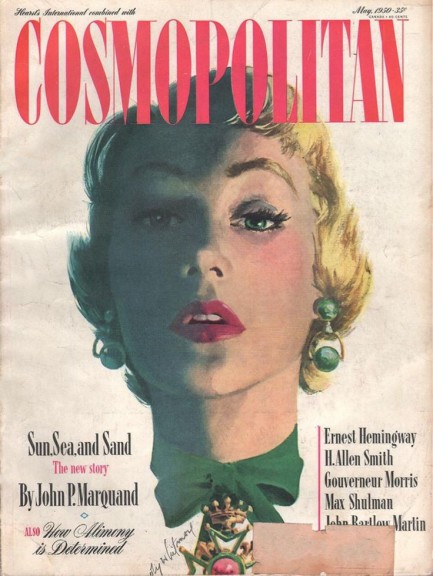 doing. Everything comes to a head at the annual Pirate Night ball. doing. Everything comes to a head at the annual Pirate Night ball. We really like Marquand. Always have. He's a funny and subtle writer, at least in his literary guise, and here you get that classic sense of the upper class cutting off its nose to spite its face, as club members conspire to boot a non-conformist though he's the only person bringing adventure and joy into their circle. Sun, Sea and Sand is novella length, and indeed its entirety first appeared in the May 1950 issue of Cosmopolitan, at right. The compact paperback edition, which is really little more than a pamphlet, comes from Dell, and the amusing cover art is by S.B. Jones.
 We haven’t been there but we’re pretty sure it’s nothing like this. 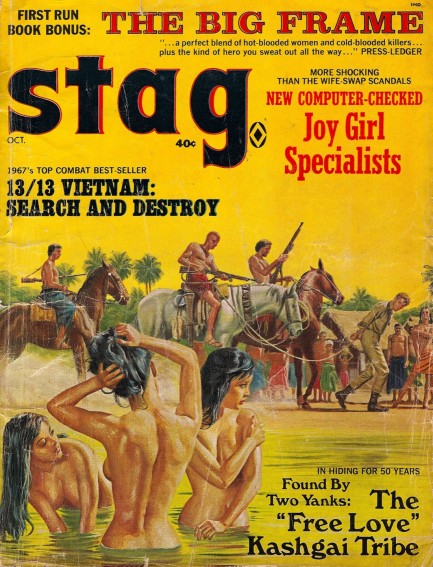
Today we have a Stag magazine from October 1967 with cover art by Mort Kunstler illustrating Emile C. Schurmacher’s exotic yarn about sex crazed women in Kashgai, Iran. Apparently free love was flowing like crude oil in the Fertile Crescent—or maybe it was just flowing in Schurmacher’s fertile imagination. That’s un-retouched color, by the way. Somehow, the magazine took some wear and tear over the years but did not fade. Content-wise, it follows the time-honored men’s magazine form, with tales of loose women, righteous violence, and international adventure, all while hitting the political hot buttons of the moment—Vietnam, hippies, and drugs. Fifteen years earlier it would have been Korea, commies, and the Mafia. The semi-gloss, two-color interior illustrations have a wonderful impact, including Charles Copland’s nice spread for W. J. Saber’s centerpiece story “The Big Frame.” Also of interest is an exposé on Wallace Groves, a Wall Street exec/felon who, after serving a prison term for mail fraud, jetted down to the Bahamas, bought 214 square miles of wilderness and turned it into the resort and gambling haven known today as Freetown. Apparently crime really does pay, especially on Wall Street, but we digress. We love how the Bahamian wilderness is described in the text as useless. One day not too very far in the future, everyone—not just scientists and environmentalists—will think of resorts and gambling havens as useless and pristine swaths of trees and wetlands as indispensable. When that day inevitably comes, stories like these will seem like profiles in civilizational lunacy, but we digress again. You also get an interesting story on Milton Helpern, an NYC pathologist who by 1967 had conducted 80,000 autopsies and been called as an expert witness in innumerable trials, typically by prosecutors on behalf of murder victims. The footer on the article pits Helpern against F. Lee Bailey, the famous Boston defense attorney, with inset text telling readers that Helpern’s experience “beats any lawyer’s grandstand play any day.” We have a feeling Bailey won a few battles too. All in all, you get more than your money’s worth with Stag—great art, diverting stories, and pervasive fantasies that women the world over hang around naked waiting for a Western stud to happen along. Highly recommended publication. Scans below.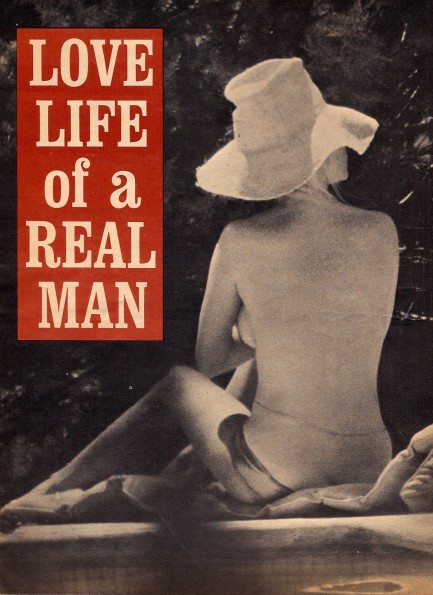    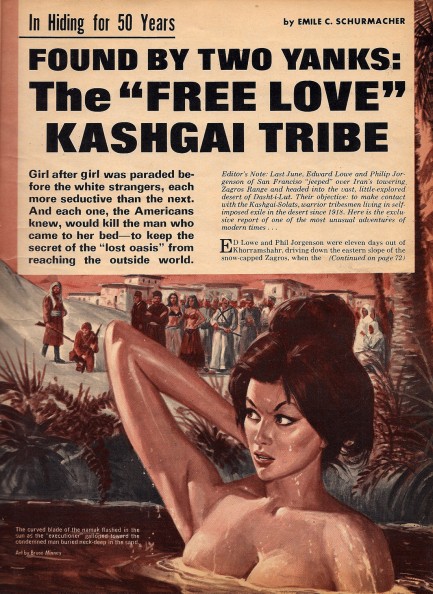 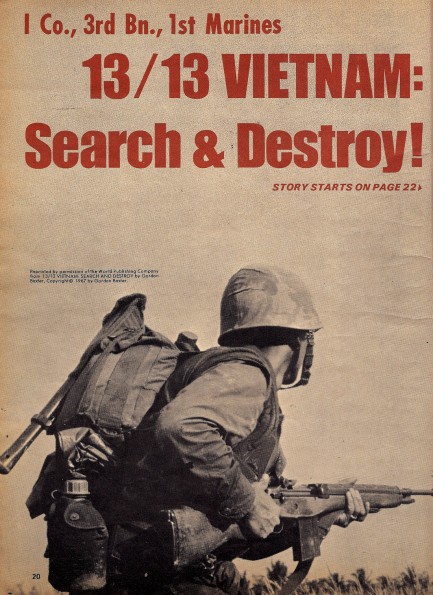 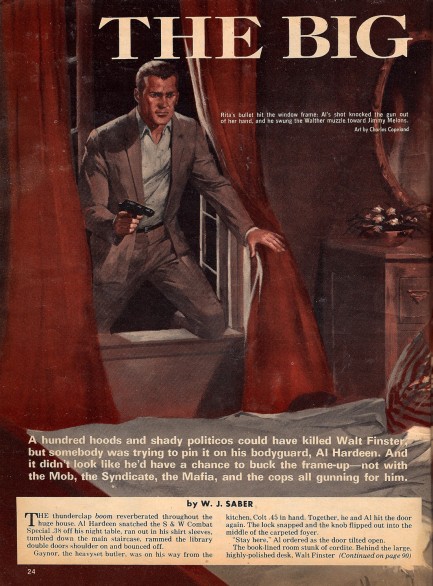 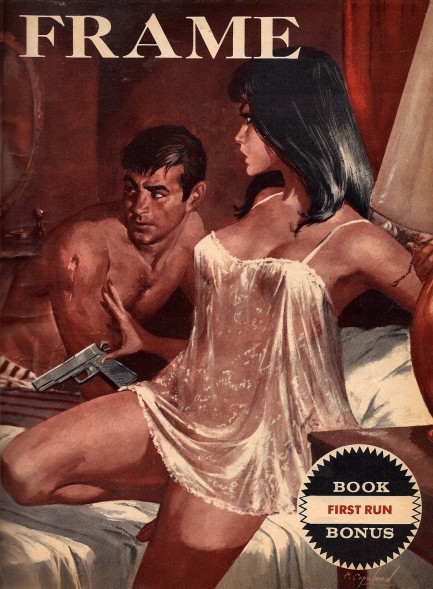 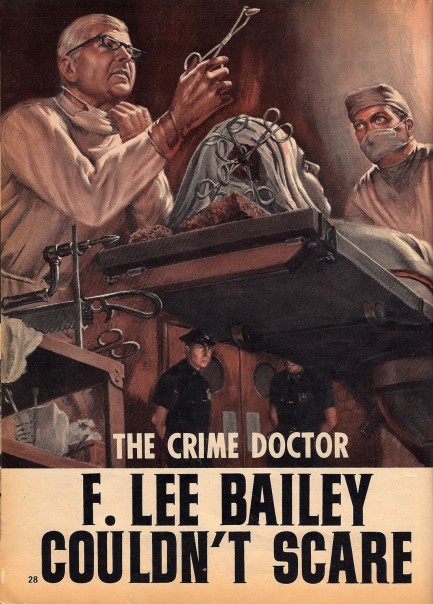 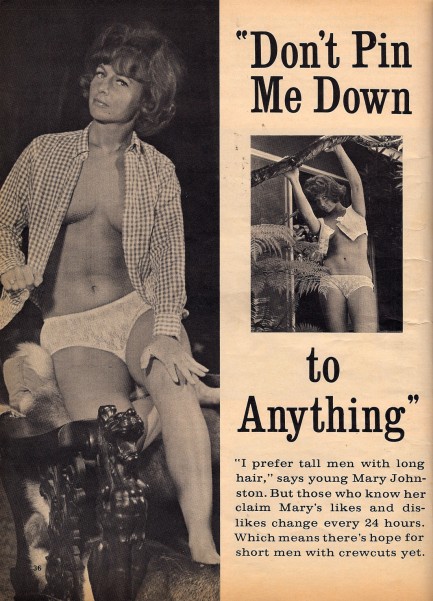 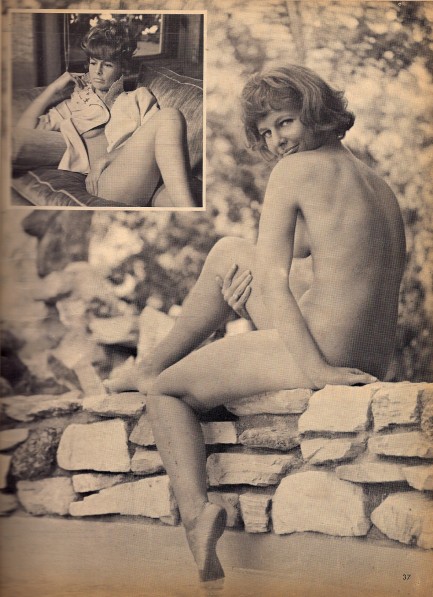 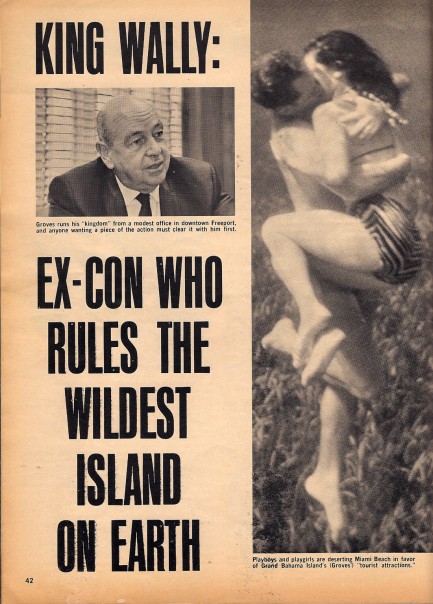 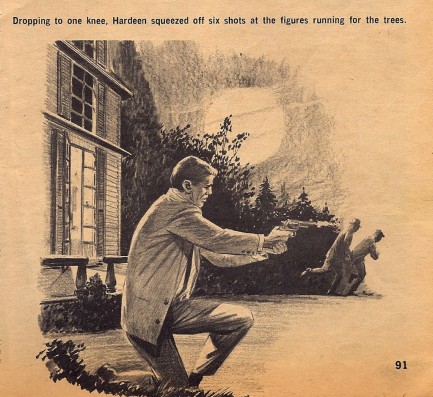 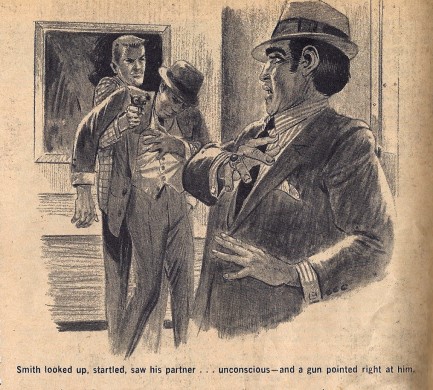 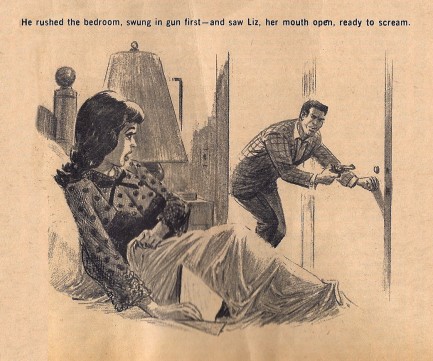 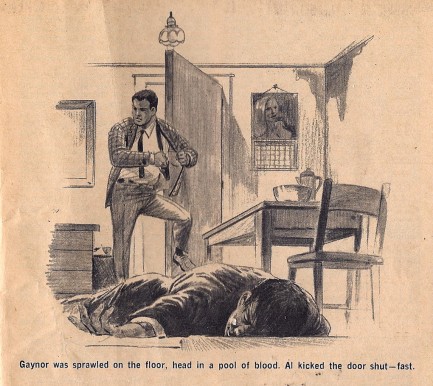 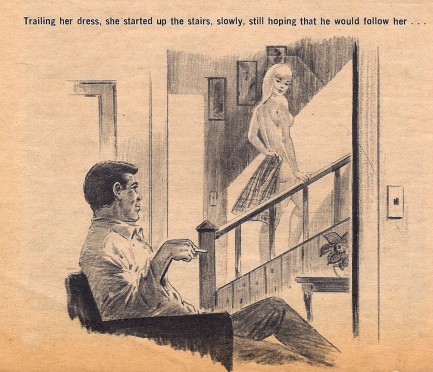 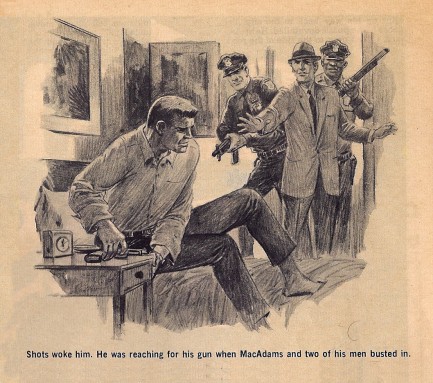 
|
 |

The headlines that mattered yesteryear.
2003—Hope Dies
Film legend Bob Hope dies of pneumonia two months after celebrating his 100th birthday. 1945—Churchill Given the Sack
In spite of admiring Winston Churchill as a great wartime leader, Britons elect
Clement Attlee the nation's new prime minister in a sweeping victory for the Labour Party over the Conservatives. 1952—Evita Peron Dies
Eva Duarte de Peron, aka Evita, wife of the president of the Argentine Republic, dies from cancer at age 33. Evita had brought the working classes into a position of political power never witnessed before, but was hated by the nation's powerful military class. She is lain to rest in Milan, Italy in a secret grave under a nun's name, but is eventually returned to Argentina for reburial beside her husband in 1974. 1943—Mussolini Calls It Quits
Italian dictator Benito Mussolini steps down as head of the armed forces and the government. It soon becomes clear that Il Duce did not relinquish power voluntarily, but was forced to resign after former Fascist colleagues turned against him. He is later installed by Germany as leader of the Italian Social Republic in the north of the country, but is killed by partisans in 1945.
|

|
|

It's easy. We have an uploader that makes it a snap. Use it to submit your art, text, header, and subhead. Your post can be funny, serious, or anything in between, as long as it's vintage pulp. You'll get a byline and experience the fleeting pride of free authorship. We'll edit your post for typos, but the rest is up to you. Click here to give us your best shot.

|
|











 vessel, but at that point things went from bad to worse when she passed out. They got her atop the boat but could do nothing but drift. They bobbed on the waters for hours until they neared a small coral reef, decided to brave the sharks, and swam for it. There they spent the night, lacking supplies of any sort, with the tide rising until they were almost back in the sea again. At daybreak they saw that Rose Island was nearby. With the tide out, they were able to walk, wade, and swim to it.
vessel, but at that point things went from bad to worse when she passed out. They got her atop the boat but could do nothing but drift. They bobbed on the waters for hours until they neared a small coral reef, decided to brave the sharks, and swam for it. There they spent the night, lacking supplies of any sort, with the tide rising until they were almost back in the sea again. At daybreak they saw that Rose Island was nearby. With the tide out, they were able to walk, wade, and swim to it.
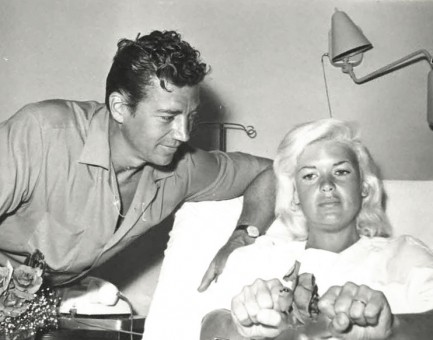
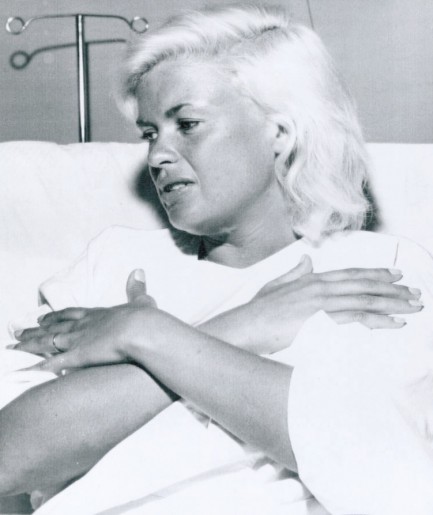







 doing. Everything comes to a head at the annual Pirate Night ball.
doing. Everything comes to a head at the annual Pirate Night ball.
























































































